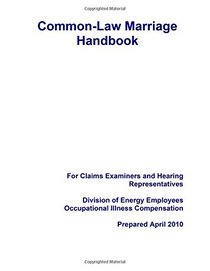Search -
Common-Law Marriage Handbook
CommonLaw Marriage Handbook
Author:
This handbook is intended to assist claims examiners in the identification and development of survivor claims that involve potential common-law marriages (these are informal relationships that can sometimes be legally recognized as valid marriages) filed under the Energy Employees Occupational Illness Compensation Program Act of 2000 (EEOICPA). ... more »
Author:
This handbook is intended to assist claims examiners in the identification and development of survivor claims that involve potential common-law marriages (these are informal relationships that can sometimes be legally recognized as valid marriages) filed under the Energy Employees Occupational Illness Compensation Program Act of 2000 (EEOICPA). ... more »
ISBN-13: 9781500500580
ISBN-10: 1500500585
Publication Date: 7/13/2014
Pages: 52
Rating: ?
ISBN-10: 1500500585
Publication Date: 7/13/2014
Pages: 52
Rating: ?
0 stars, based on 0 rating
Publisher: CreateSpace Independent Publishing Platform
Book Type: Paperback
Members Wishing: 1
Reviews: Amazon | Write a Review
Book Type: Paperback
Members Wishing: 1
Reviews: Amazon | Write a Review
Genres:
- Reference
- Law >> Family Law >> Marriage




